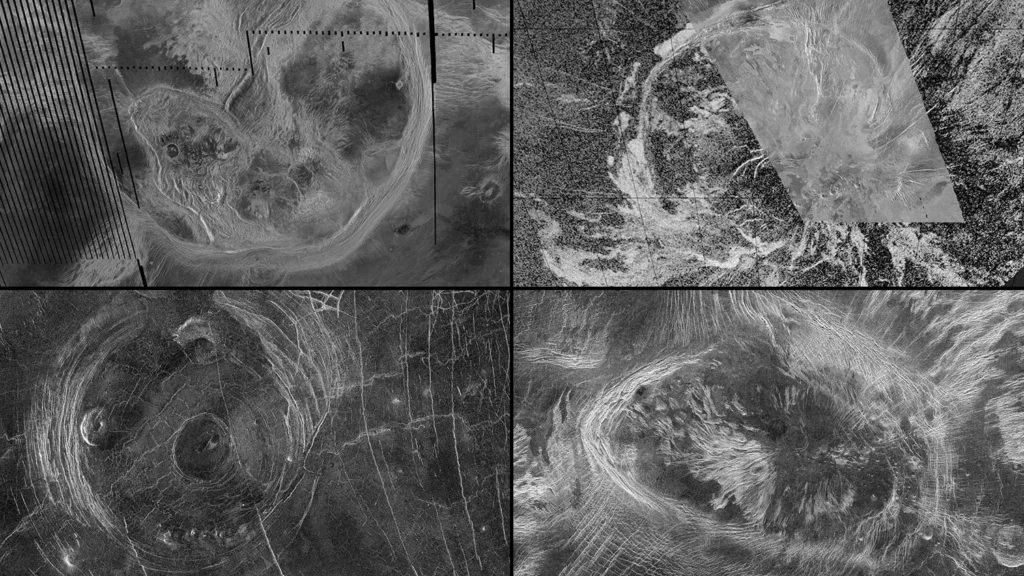
Unlocking the Mystery of Tectonic Activity on Venus
In a stunning scientific development, NASA researchers have uncovered new evidence of tectonic activity on Venus, revealing that the planet’s surface may still be reshaped by forces beneath. By analyzing data collected more than three decades ago during NASA’s Magellan mission, scientists have identified signs that Venus — long thought geologically dormant — may still experience dynamic, Earth-like processes.
While Earth’s surface is constantly recycled by shifting tectonic plates, tectonic activity on Venus happens differently. The planet lacks moving plates, yet researchers now believe that its surface is deformed by rising plumes of hot material from the mantle. These findings are changing our understanding of how rocky planets evolve.
What Is Tectonic Activity on Venus?
The term tectonic activity on Venus refers to processes like lithospheric deformation, subsurface plumes, and even subduction-like movements — all occurring without traditional plate tectonics. A key indicator of these processes is a type of surface structure called a corona.
Coronae are massive, circular to oval-shaped geological features, often hundreds of miles wide. Scientists believe they form when hot mantle plumes push upward against the lithosphere, causing the surface to bulge and crack. Studying these coronae offers a direct window into Venus’ internal activity and how it shapes the surface.
Magellan Mission and the Hunt for Tectonic Activity on Venus
Launched in 1989, the Magellan mission used advanced radar imaging to penetrate Venus’ thick clouds, producing the first detailed maps of its surface. These maps revealed hundreds of coronae, whose origins were initially mysterious.
In recent years, researchers revisited the Magellan data with modern tools and modeling techniques. The result? A landmark study published in Science Advances showed that 52 of 75 coronae examined likely have active mantle plumes beneath them, directly supporting the theory of ongoing tectonic activity on Venus.
How Coronae Reflect Tectonic Activity on Venus
To understand the mechanisms behind tectonic activity on Venus, scientists modeled several geological scenarios involving coronae. Here are the key processes they identified:
- Corona-Induced Subduction
Unlike Earth’s plate-driven subduction, this process is caused by upward pressure from mantle plumes, which push the surface outward. In areas where this outward movement collides with other regions, material is driven downward into the mantle. - Lithospheric Dripping
This phenomenon occurs when cool, dense sections of the lithosphere sink into the hotter mantle, much like blobs of syrup sinking into water. This contributes to surface deformation and is a potential driver of tectonic activity on Venus. - Plume-Driven Volcanism
In regions where the lithosphere is thicker, trapped plumes may create enough pressure to generate volcanic eruptions, further reshaping the surface.
These processes help explain why coronae are common in regions where Venus’ lithosphere is thin and internal heat flow is high — key indicators of active tectonic behavior.
Why Tectonic Activity on Venus Matters for Earth Science
Studying tectonic activity on Venus offers vital clues to our own planet’s past. Earth may have once undergone similar processes before plate tectonics became dominant.
“Coronae are not found on Earth today, but they may have existed when Earth was young,” notes Gael Cascioli, lead author of the study. Understanding coronae may help scientists model how early Earth’s mantle behaved, before plate tectonic cycles began to govern our planet’s geology.
VERITAS: The Future of Studying Tectonic Activity on Venus
Looking ahead, NASA’s upcoming VERITAS mission (Venus Emissivity, Radio Science, InSAR, Topography, and Spectroscopy) aims to greatly enhance our understanding of tectonic activity on Venus. Set to launch no earlier than 2031, VERITAS will provide:
- High-resolution 3D maps of Venus’ surface
- Gravity measurements to study mantle structures
- Spectroscopy to analyze surface composition
The mission’s enhanced gravity data will improve on Magellan’s by a factor of 2 to 4 — helping scientists pinpoint areas of active tectonic change.
Additional Evidence: Volcanism and Surface Reshaping
In addition to coronae, Magellan imagery has recently revealed surface changes from volcanic activity — especially around Maat Mons and Sif Mons. These eruptions, confirmed via radar image comparisons, add to the growing body of evidence that Venus is still geologically alive.
This supports the idea that tectonic activity on Venus may be driving not only surface deformation but also volcanic resurfacing, just as mantle plumes on Earth create island chains like Hawaii.
Conclusion: A New View of Tectonic Activity on Venus
The discovery of ongoing tectonic activity on Venus is revolutionizing planetary science. Far from being a dormant wasteland, Venus now appears to be a planet with internal heat, active mantle dynamics, and a surface constantly being reshaped — much like Earth, but in its own unique way.
As we await VERITAS, the scientific community stands at the edge of a new era of exploration. Tectonic activity on Venus may soon offer the missing pieces needed to fully understand both our neighboring planet and the early history of our own world.
Great insights! This really gave me a new perspective. Thanks for sharing.